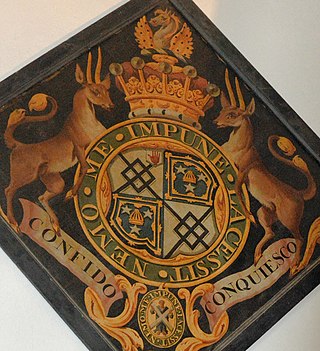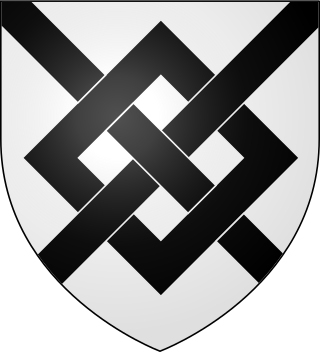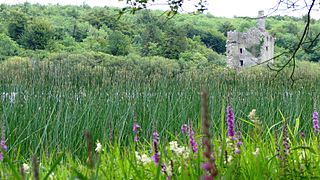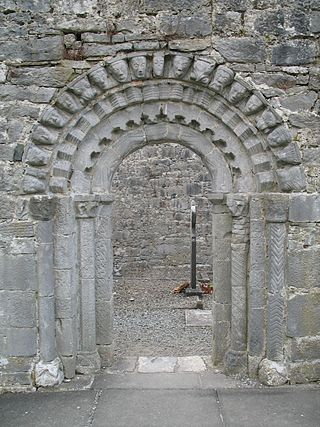
Croke Park is a Gaelic games stadium in Dublin, Ireland. Named after Archbishop Thomas Croke, it is referred to as Croker by GAA fans and locals. It serves as both the principal national stadium of Ireland and headquarters of the Gaelic Athletic Association (GAA). Since 1891 the site has been used by the GAA to host Gaelic sports, including the annual All-Ireland in Gaelic football and hurling.

Earl of Dysart is a title in the Peerage of Scotland. It was created by King Charles I in 1643 for William Murray and has been held continuously since then by his descendants.

Buckminster is a village and civil parish within the Melton district of Leicestershire, England, which includes the two villages of Buckminster and Sewstern. The total population of the civil parish was 335 at the 2021 census. It is on the B676 road, 10 miles east of Melton Mowbray and 4 miles west of the A1 at Colsterworth.

O'Dea Castle, also known as Dysert O'Dea Castle, is an Irish fortified tower house, loosely described as a castle at Dysert O'Dea, the former O'Dea clan stronghold, 5 kilometres (3 mi) from Corofin, County Clare. It was built between 1470 and 1490 by Diarmaid O'Dea, Lord of Cineal Fearmaic, and stands some 50 feet (15 m) high on a limestone outcrop base measuring 20 by 40 feet. The tower is adjacent to Dysert O'Dea Monastery, close to the R476 road.

Dysart is a former town and royal burgh located on the south-east coast between Kirkcaldy and West Wemyss in Fife. The town is now considered to be a suburb of Kirkcaldy. Dysart was once part of a wider estate owned by the St Clair or Sinclair family. They were responsible for gaining burgh of barony status for the town towards the end of the 15th century.

Gaelic handball is a sport where players hit a ball with a hand or fist against a wall in such a way as to make a shot the opposition cannot return, and that may be played with two (singles) or four players (doubles). The sport, popular in Ireland, is similar to American handball, Welsh handball, fives, Basque pelota, Valencian frontó, and more remotely to racquetball or squash. It is one of the four Gaelic games organised by the Gaelic Athletic Association (GAA). GAA Handball, a subsidiary organisation of the GAA, governs and promotes the sport.

Ballyforan is a village in south County Roscommon, Ireland on the R363 road between Ballygar and Dysart. It lies beside the River Suck which separates County Roscommon and County Galway.
Oldtown is a population centre and townland in the civil parish of Clonmethan in Fingal, Ireland. The R122 road runs through the village linking Naul to St Margaret's and Dublin Airport.

Sir Lionel Tollemache, 3rd Baronet (1624–1669) of Helmingham Hall in Suffolk, was the head of a prominent East Anglian family. He was the son of Sir Lionel Tollemache, 2nd Baronet and Elizabeth Stanhope, daughter and heiress of John Stanhope, 1st Baron Stanhope of Harrington.
Dysart is a village in County Roscommon, Ireland. It lies 20 km (12 mi) from the centre of Athlone, on the R363 regional road. Located at the crossroads of the R363 and the R357, the village was formerly known as 'Thomas Street'.

The Tollemache family is an English noble family, originally from Suffolk. The family's surname is pronounced TOL-mash.

Ruan is a village in County Clare in Ireland. It is in the Catholic parish of Dysart and Ruan.

Bannow is a village and civil parish lying east of Bannow Bay on the south-west coast of County Wexford, Ireland. In modern times the main settlement is the village of Carrig-on-Bannow. In Norman times there was a borough called Bannow on Bannow Island at the mouth of the Bay. This town has since disappeared, probably due to the silting up of the natural harbour channels in the 14th century, and the former island is now attached to the rest of the parish.

A tolbooth or town house was the main municipal building of a Scottish burgh, from medieval times until the 19th century. The tolbooth usually provided a council meeting chamber, a court house and a jail. The tolbooth was one of three essential features in a Scottish burgh, along with the mercat cross and the kirk (church).
Wenefryde Agatha Scott, 10th Countess of Dysart was a Scottish noblewoman.

Dysart and Ruan is a Catholic parish in County Clare, Ireland. It covers the civil parishes of Ruan and Dysert, and includes the village of Ruan, which holds the parish office. The parish contains the ruins of the 12th century St. Tola's Church, part of Dysert O'Dea Monastery.

Langham House is a Grade II-listed house facing Ham Common in the London Borough of Richmond upon Thames. It was built in about 1709 and former home of several notable residents.

Welsh handball is one of the ancient native sports of Wales. It is related to coeval sports such as Irish handball, fives, and Basque pelota and is a possible antecedent of American handball. The sport has been continually attested since the Middle Ages and its popularity saw it become an important expression of Welsh culture, offering ordinary people opportunities through prize money, bookkeeping and even player professionalism.

Dysart is a village in County Westmeath, Ireland. It is located on the R391 road, to the west of Mullingar. Lough Ennell is located to the east.

Dysart Tolbooth and Town House is a municipal building in the High Street, Dysart, Fife, Scotland. The structure, which was comprehensively restored in 2009, is a Category A listed building.
















